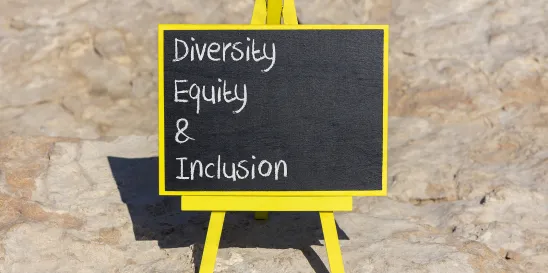During recent oral arguments in a case that could shift the balance in employment discrimination cases and impact employer diversity, equity, and inclusion (DEI) and environmental, social, and governance (ESG) initiatives, justices for the Supreme Court of the United States struggled to get clear answers on whether unlawful employment discrimination under Title VII of the Civil Rights Act of 1964 requires employees to show they were injured by the alleged discrimination. In this third installment of Ogletree Deakins’ “DEI Under Scrutiny” blog series, we focus on the Supreme Court’s consideration of an employment discrimination case that could open the floodgates to reverse discrimination claims.
Quick Hits
- The Supreme Court is considering a case that could provide clarity over whether Title VII’s prohibition of employment discrimination requires a plaintiff to show the discrimination caused an injury.
- A ruling that Title VII does not require a threshold showing of injury could dramatically increase the number of employment discrimination claims, including reverse discrimination claims over employer DEI and ESG efforts.
- A ruling is expected by the end of the Supreme Court’s term in the summer of 2024.
On December 6, 2023, the Supreme Court of the United States held oral arguments in City of St. Louis v. Muldrow, a case that asks whether a female police officer’s unlawful discrimination claim over a forced lateral job transfer allegedly because of her sex is actionable under section 703(a)(1) of Title VII of the Civil Rights Act of 1964.
During Supreme Court oral arguments, the justices questioned counsel for the parties over whether a Title VII discrimination claim requires a plaintiff to show the alleged discrimination caused an injury or whether the discrimination based on a protected characteristic itself is the injury.
While it seemed a group of the justices agreed there should be some threshold for making a discrimination claim actionable, many of the justices seemed to agree that the transfer issue as presented (despite some questions over what facts were actually conceded) in the case before it seemed to qualify as an actionable Title VII issue.
Given its potential to trigger a spike in employment discrimination cases, civil rights advocacy groups, employers and conservative activists are closely watching the case. A ruling that Title VII does not require a plaintiff to show harm, or that discrimination based on a protected class is inherently injurious, could expand actionable Title VII claims beyond traditional claims of adverse employment actions, such as challenging hiring, firing, and promotion decisions.
In particular, a ruling that Title VII does not require an injury could ease the path for reverse discrimination claims challenging employer DEI programs that may not have survived in court under an injury requirement. Such a result would continue the onslaught of scrutiny to employer DEI and ESG programs, which have come under increased scrutiny from activist groups, investors, employees, and others since the Supreme Court’s June 2023 decision on race-conscious admissions in higher education.
Background
Jatonya Clayborn Muldrow, a former sergeant with the St. Louis, Missouri, Police Department, filed a Title VII lawsuit alleging that her commander forced her to transfer from her position in police intelligence to another department without warning because of her sex. She alleged that the other position had the same pay, but had different hours, responsibilities, supervisor, workplace environment, and job requirements.
The Eighth Circuit Court of Appeals found that the transfer claim was not actionable under Section 703(a)(1) of Title VII, which makes it an “unlawful employment practice for an employer” to “discriminate against any individual” based on the individual’s “race, color, religion, sex, or national origin” with respect to the “compensation, terms, conditions, or privileges of employment.” According to the Eighth Circuit, the transfer did not constitute an adverse employment action in that Muldrow did not suffer a “materially significant disadvantage.”
Circuit Split
While a majority of the circuits agree that a Title VII discrimination claim requires an injury to the plaintiff, the circuits vary in the degree of harm that is required to be shown. Deviating from the harm requirement, in June 2022, the D.C. Circuit Court of Appeals held, in Chambers v. District of Columbia, that an employer that transfers an employee or denies a requested transfer based on the employee’s membership in a protected class “violates Title VII by discriminating against the employee with respect to the terms, conditions, or privileges of employment.”
Additionally, the Fifth Circuit, in its August 2023 en banc decision in Hamilton v. Dallas County, reversed the circuit’s long-standing restriction that Title VII claims be based on an “ultimate employment decision,” thereby broadening the types of adverse employment actions that could give rise to an actionable Title VII claim in the circuit. The Fifth Circuit reasoned that limiting Title VII to “ultimate employment decisions” ignored the “terms, conditions, or privileges of employment” language of Title VII.
In a concurring opinion, Fifth Circuit Judge James Ho emphasized how the Hamilton decision, in the context of the Supreme Court’s 2023 affirmative action case, will place employer DEI programs under scrutiny by “restor[ing] federal civil rights protections for anyone harmed by divisive workplace policies that allocate professional opportunities to employees based on their sex or skin color, under the guise of furthering diversity, equity, and inclusion.”
Actionable Harm
During oral arguments in Muldrow, counsel for Muldrow argued that differential treatment alone is sufficient to allege a Title VII violation because it can create a stigma, noting that differential treatment is, in most circumstances, “worse” treatment.
However, while the justices seemed to agree that a job transfer like that at issue in Muldrow affects the “terms, conditions, or privileges of employment,” they questioned whether Title VII’s language “discrimination against” (emphasis added) means an employee must be disadvantaged, as opposed to distinctions made between employees based on membership in a protected class that did not cause harm to the terms, conditions, and privileges of employment.
“It’s a funny sentence to write, distinctions or differences in treatment that injure protected individuals, if you think that all distinctions and differences injure protected individuals,” Justice Elena Kagan questioned in trying to state the rule.
Justice Samuel Alito questioned whether there should be “some sort of threshold that has to be cleared before the matter gets into court … whether it’s de minimis, whether it’s significant disadvantage” or some other “terminology.”
Justice Brett Kavanaugh suggested that the limit on potential Title VII claims is that the alleged discrimination must affect the terms, conditions, or privileges of employment, and as the D.C. Circuit Court wrote, not everything in the workplace affects terms, conditions, or privileges of employment. Still, he noted that job transfers are in the “heartland” of Title VII terms, conditions, or privileges.
Justice Ketanji Brown Jackson suggested the text of Title VII does not need a plaintiff to show “concrete harm” as a result of discrimination, and, if anything, lack of harm is an issue of potential damages. If a plaintiff brings a discrimination case after being transferred to an essentially similar position, then a jury might say the plaintiff has been discriminated against “but your damages are zero,” Justice Jackson reasoned.
The Biden administration, which joined the case backing Muldrow, argued that the only actionable harm Title VII requires is “being denied equal treatment because of a protected characteristic.” But the counsel for the government conceded that there are some “innocuous” distinctions, such as dress codes and bathrooms that do not give rise to actionable Title VII discrimination, at least with regard to sex discrimination.
DEI Initiatives
Counsel for Muldrow and the government struggled with questions of how Title VII might impact employer DEI initiatives that give preferences or benefits to employees based on sex or race to promote diversity—particularly if a plaintiff is not required to show harm.
Counsel for Muldrow argued that even in a case where there is no perceived direct harm, for example, if women were given raises because they are women, there could still be an actionable Title VII discrimination claim. Such a situation, he argued, could create a stigma that the women did not earn their raises, giving rise to Title VII claims. Under such a situation, men who did not get raises may also have a discrimination claim of their own.
Justice Amy Coney Barrett asked whether that contention would mean that giving promotions to Black employees to increase diversity in the workplace would be discrimination. More specifically, Justice Barrett asked whether it would be discrimination if a law firm, in order to increase the number of female attorneys and show that it is “friendly to women,” gave women raises.
Similarly, Justice Clarence Thomas pressed the government on whether a police department that transfers police officers based on race to precincts where it believes it needs more Black or Hispanic officers would be actionable under Title VII.
But while counsel for Muldrow and the government agreed that certain DEI efforts might be discrimination under certain circumstances, they pointed out that such issues were not directly before the Court. The government conceded that a transfer based on race would likely violate the clear meaning of Title VII.
Counsel for the government stated, “We think that there is adequate room within the bounds of Title VII to create opportunities for diversity.” Still, this line of questioning from the justices shows that the Court is focused on DEI issues and that the ruling in this case could impact DEI initiatives going forward.
Looking Ahead
It is not clear exactly where the justices will land in Muldrow, but from oral arguments, it appears there could be a ruling limited to the facts of job transfers. It is clear that many of the justices are focused on DEI issues. Private employers may want to determine their risk tolerance, evaluate their ESG and DEI programs, and develop a cohesive approach to mitigating risk.
A decision in Muldrow is expected by the end of the Supreme Court’s term in the summer of 2024.
For more information on the implications of the Supreme Court’s affirmative action decisions for DEI initiatives, together with related risk considerations for employers, please see Ogletree Deakins’ “DEI Under Scrutiny” series, which examines the DEI legal landscape in the wake of the Supreme Court’s decision on race-conscious admissions in higher education.
Part one of the series examines reasons to perform risk assessments of DEI programs given the current legal landscape. Part two of the series focuses on additional considerations related to employers’ environmental, social, and governance (ESG) commitments.






 />i
/>i

